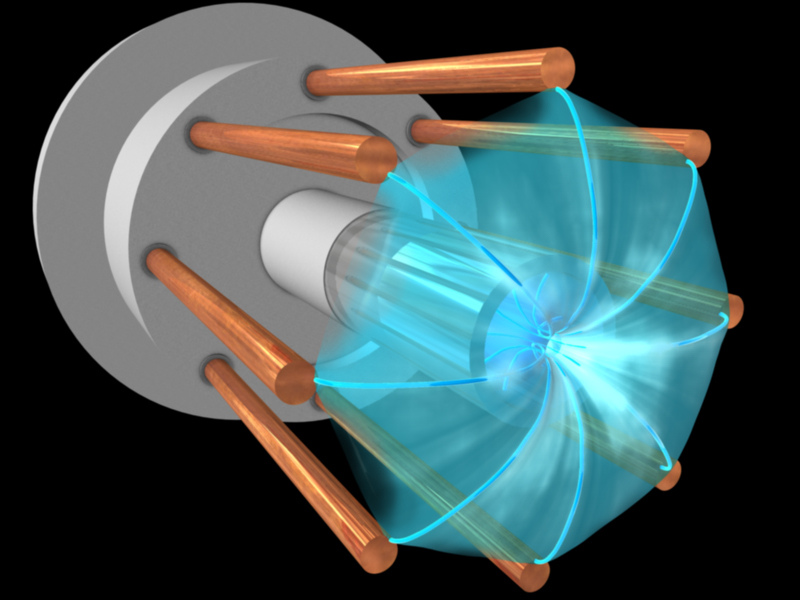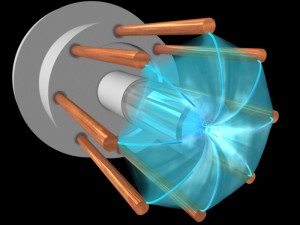March 28, 2014 – From an MIT conference held in the last week on cold fusion to the latest refusal to grant a U.S. patent for Andrea Rossi’s E-Cat, to a company developing what it calls dense plasma fusion, the future of cheap, clean, nuclear energy still appears to be a dream with no immediate breakthroughs.
The MIT conference took place on March 21 to 23 and commemorated the 25th anniversary of the announcement by Pons and Fleischmann that introduced us to a process they called cold fusion. I have written a number of postings about cold fusion, a technology which spontaneously transmutes one element into another with the byproduct being anomalous heat. As of yet, however, from all those working on experiments in cold fusion, no one has yet to produce a working low energy nuclear reactor that can be packaged into a power generator for the kinds of applications promised like heating a house or providing the power plant to drive a car. It appears from the few postings that have emerged from the MIT conference that the commercial dream for cold fusion remains elusive. Those dedicated to the subject are still tinkering. So are we a year, 5 years, 10 years away from a commercial cold fusion reactor? My hunch is the 10-year timeline is too optimistic.
Why do I say that? Because no one in a patent office seems convinced there is anything to the technology. At least that’s the case at the U.S. Patent office with its latest preliminary rejection of Andrea Rossi’s E-Cat patent filing. Rossi, who recently sold his LENR rights to an American company, Industrial Heat, just can’t seem to get a break from those issuing patents in almost every country where he attempts to file. I quote from E-Cat World’s publication of the patent examiner’s comments in which he states:
- “The specification is objected to as inoperable. Specifically there is no evidence in the corpus of nuclear science to substantiate the claim that nickel will spontaneously ionize hydrogen gas and thereafter “absorb” the resulting proton…”
- “There is presently no peer-reviewed evidence to demonstrate the spontaneous fusion of nickel and protons…”
- “Additionally the Examiner notes that if the reaction occurred as claimed by the Applicant, it would also spontaneously occur in nature.. not be patentable subject matter…..”
- “…the specification and all claims are found to be inoperable.”
Which brings me to Lawrenceville Plasma Physics, and the development of a technology referred to as focus fusion. Unlike Rossi’s E-Cat LENR, what Lawrenceville is doing has received a U.S. patent. What’s involved?
Dense plasma fusion uses a device containing two cylindrical copper or beryllium electrodes enclosed in a vacuum chamber with low-pressure gas injected to fill the space between them. When an electrical pulse is introduced the gas heats and an intense magnetic field creates a plasma which travels the length of the electrode where it becomes dense and forms a plasmoid. This induces two beams to flow, one containing electrons, the other ions. The electrons heat the plasmoid to billions of degrees Celsius. The ions collide and fuse contributing more heat to the plasmoid. All this happens in a mere 10 nanoseconds (10 billionths of a second). The net result – more energy out than in and the potential for a commercial fusion reactor that would produce environmentally clean, cheap energy with little to no radioactive waste. The byproduct of fusion using this process is helium, a much sought after gas here on Earth. The only radioactive byproduct, low-energy neutrons can be handled by housing the reactor in a few layers of shielding.
So how close are we to a commercial device? Well don’t count on something appearing on the market soon because it appears that a commercial dense plasma fusion reactor is as close to market as we humans are willing to fund it. Lawrenceville appears to be spending as much time seeking funds as it is doing research. It has used crowdfunding, small grants from NASA’s Jet Propulsion Laboratory, and institutional and private investment to bankroll it to date. This hasn’t amounted to a lot of money. The company has even posted a wish list seeking donations of equipment to help it continue its research. Sounds very much like a startup and a company flying by the seat of its pants. So a commercial fusion reactor on the market soon? Don’t hold your breath!





















[…] Follow this link: A look at the current state of cold and hot fusion research. […]
The critics of the expert are based on theory and are this without interest in that domain.
Moreover the theory in the patent seems even no more supported by Rossi…Red herring at best.
I see two real weakness to that patent :
– first, since the theory is not known, there must be reasonable proof of working, whichi is the purpose of the expected Elforsk report, after the Levi&al 2013 paper. This paper is already quite enough, and the critics of Eriksson&pomp are so preposterous and incompetent (see the analysis of that pamphlet http://ecatnews.com/?p=2620 by a participant) that it let some impression that nobody serious have something to say. I am shocked that the expert di not use that test as enough to prove the reality of the technology
– second, this patent is very bad as a patent. It does not gives enough detail to build the reactor. It should not be granted.
Industrial heat claim to have filed more patent, and I expect they do it like professional.
what is more shocking is that all the disbeliefs is based on nonthing else the refuted claims of about 5 bad scientsits : lewis (refuted as incompetent critic by many even Wilson), Hansen (refuted as incompetent critic by even Wilson), Huizenga (whose carefully refused to integrate data after 1989 and whi invent fraud when facts disagree), Gary taubes and Morisson (caught is similar unethical claims despite third party rebutal), and maybe a few one I forgot…
see there (Excess Heat by Charles Beaudette)
http://iccf9.global.tsinghua.edu.cn/lenr%20home%20page/acrobat/BeaudetteCexcessheat.pdf
unlike the Taubes&Huizenga awful conspiracy books, this book have reference where you can check the facts, even aftet 1989.
and there (Titanic paper by Jed Rothwell, see page 4)
http://www.lenr-canr.org/acrobat/RothwellJcoldfusion.pdf
if you don’t trust, check the facts.
all the others techniques, like time to replicate it, difficulties, seing the real pre-nobel story of high-temperature superconduction, when it was footnote and rejected paper
http://www.mosaicsciencemagazine.org/pdf/m18_03_87_04.pdf
http://www.iccf17.org/popup/bio_5.htm
The history of semicondustor (the real, started in the 1920s) is not different.
Thomas Kuhn theory is no more that being aware of that…
It is a bit like rediscovering the moon, but like Gary Taubes don’t know electricity, like Lewis is incompetent in calorimetry, most scientist are uneducated in (real) scientific history… at best they know the fairy tale of Wikipedia.
People interested in the domain should really investigate, and start from the links and the footnote I gave.
By the way, I make a call to honest skeptics:
If you have even ONE paper that challenge F&P, McKubre,Miles, Oriani calorimetry I am interested.
For now only Shanahan was able to provide anything,challenging LENR calorimetry.
The rebuttal of Shanahan paper is easy because it does not cover some experiments, does not match experiments (blanks, burst, heat after death, boiling) , and is a never observed claim in the domain of calorimetry…
in 1996, before Shanahan theer was only 4 written critics, all rebutted.
(see the book Excess Heat by Charles Beaudette http://iccf9.global.tsinghua.edu.cn/lenr%20home%20page/acrobat/BeaudetteCexcessheat.pdf for the details)
Lewis and hansen, for incompetent claims not matching facts. sadly Lewis (despite he was refuted and he visited McKubre and found nothing) continue to claim his fairy tale.
Morrisson for mixing all (sadly he continue to sell his erroneous soup as the Titanic pare report).
Wilson was the only competent critic, and he introduced possible corrections. they are not enough to refute the most important measured heat.
No chemical phenomenon can explain the observed heat, even alien.
No artifact have been observed, unlike with the early failed attempts who beside missing key conditions, did use bad calorimetry (see http://newenergytimes.com/v2/conferences/2012/ICCF17/papers/Miles-Examples-Isoperibolic-Calorimetry-ICCF17-ps.pdf )
No fraud have been observed except for the MIT negative results who recalibrated to make anomalous heat disappear…
http://www.infinite-energy.com/images/pdfs/mitcfreport.pdf
http://www.larouchepub.com/eiw/public/1991/eirv18n37-19910927/eirv18n37-19910927_052-clearing_the_air_about_the_cold.pdf
please no theory… just calorimetry. The “Beaudette’s Doctrine”.
best regards, and thanks in advance for your help
So these Cold Fusion guys are hunting a fantom?
It’s so easy to publish an opinion when you are ignorant and only reading those things you want to read.
There are thousands of published papers about anomalous heat production when metals are soaked in a hydrogen or deuterium atmosphere or (heavy-) water. There is no theory which can explain this, but analysis shows TRANSMUTATION of metal and hydrogen/deuterium atoms. The heat production cannot be explained nor the transmutation, but why isn’t that being investigated intensively?? It is so easy to do with such a relatively tiny investment.
No, instead huge and extremely expensive apparatus are being constructed to try hot fusion. These machines are using a thousand-fold of energy that they can produce at this moment, whereas cold fusion now already produces 5-10 times more energy as it needs. If you had to pay for the research, which would you choose? Cold Fusion or Hot fusion?
But no, we should not even ask us this question. Science is obliged to investigate the heat and transmutation. We should know why this happens and if it cannot happen according our theories than maybe our theories are incomplete or wrong!
What would I do? I would investigate both and try to find a new energy source as soon as possible. Try to avoid the dark future of diminishing energy supplies, global warming and reliance of Russia on gas supplies and I would NEVER take any step to forbid either route, unless the world safety is at stake.
It appears that independent research will continue to explore the Pons Fleischmann phenomenon. The anomalous heat generated by the chemistry is just too intriguing. But will something commercial come out of it? I’m not holding my breath.
the commercial application seems near at the industrial timescale (few semester, few years).
Investor start to fund million for the leaders (Brillouin, E-cat) and the 100k$ start to leak in research startups…
http://www.lenrftw.net/home/are-low-energy-nuclear-reaction-devices-real
http://www.lenrnews.eu/lenr-summary-for-policy-makers/
See Elforsk position
http://www.elforsk.se/Global/Trycksaker%20och%20broschyrer/elforsk_perspektiv_nr2_2013.pdf#page=4
and China position
http://www.icebank.cn/news/detail_2.php?id=113
and weapon makers
http://www.lenrnews.eu/revolutionizing-the-future-of-battlefield-energy-advanced-power-sources-based-on-lenr-george-miley/
and nasa/boeing/lockeedmartin
http://www.lenrnews.eu/about-nasa-research-are-cold-fusionlenr-planes-already-feasible/
it will not be easy, but it is time to panic already.
some in fact are already preparing for the race , in silence. in US it is already visible.
what is amazing is that you hear nobody acknowledging those facts, notr even insulting the boss of national instrument, Cherokee fund, asking them to resign…
no no critic, just … silence
at worst some critic and pathetic lies and undocumented errors on the weakest ring, like Rossi.. but nobody against SRI/Brillouin/Navy/DoD/ENEA, NASA/Boeing/Lockeed,ST Micro, Toyota/technoba, Chinese Baoding HIDZ … just silence.
The silence either speaks volumes about the lack of progress, or suggests secretiveness. I think the former more than the latter.